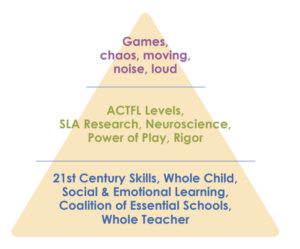
‘When Edison was discovering the lightbulb, he first engaged in a process of envisioning how an unseeable current of energy could be harnessed and turned into light. Like most of us, the vision came first. Once he understood what came to him, it took quite some time to find the precise material that would work…’ ‘Later, when asked if he ever grew discouraged or thought he was wasting his time, Edison said no, he learned something important each time he tried. He learned that there was another material not to be used.’
This excerpt from The Book of Awakening by Mark Nepo resonates, as starting anything new begins with the vision. I remember having a vision for what I wanted: a classroom that would look, sound and feel different. A place where language was real and tangible, and students were engaged and motivated. I had specific goals and values that I wanted and I put those at the forefront.
- To be part of a community and build relationships
- To instill Intrinsic motivation and student ownership
- To not be afraid of an immersive environment
- To create an immersive environment
- To take risks and make mistakes
- To infer & circumlocute
I didn’t know what that would look like, yet I set about looking for the precise ‘materials’ that would make it work. Each time I’d try something on, however, I felt much like Goldilocks saying, ‘this just isn’t quite right‘. I continued exploring my own beliefs, researching best practices and testing out research-based strategies. I tried new combinations of things and took huge risks. I followed my gut and tried things that I knew felt right.
Much like Edison, I discovered a lot of things that didn’t work, yet my amazing students were always willing and along for the ride. And what we did discover together were ways that DO work. Structures, feelings and techniques that all worked together to create an atmosphere where we built a community together, where all of us had a say in it, where everyone in the classroom was on equal footing and equally contributing to the learning and growing, as much in the content as in becoming better human beings. The visual below demonstrates all the different elements that make up this dynamic, high-achieving classroom based on equality and respect.
 This synergy is achieved through trial and error, trusting yourself and trusting your students. There are no shortcuts. You can only trust your gut, feel what feels right in the classroom and what doesn’t. Are you connecting to students on an equal level of mutual respect? Can you feel the sense of community and belonging in class? If not, what is missing? OWL has developed many strategies to achieve those ends. Try them out, feel them out, and use what feels right to you. The beauty of OWL is that it allows for autonomy and discovery. Develop your own connections and strategies with kids, and give yourself permission to take those risks you’ve always wanted to try. ‘I felt that with OWL I have been given the freedom to be the teacher I wanted to be’, shared Chiara Monticelli.
This synergy is achieved through trial and error, trusting yourself and trusting your students. There are no shortcuts. You can only trust your gut, feel what feels right in the classroom and what doesn’t. Are you connecting to students on an equal level of mutual respect? Can you feel the sense of community and belonging in class? If not, what is missing? OWL has developed many strategies to achieve those ends. Try them out, feel them out, and use what feels right to you. The beauty of OWL is that it allows for autonomy and discovery. Develop your own connections and strategies with kids, and give yourself permission to take those risks you’ve always wanted to try. ‘I felt that with OWL I have been given the freedom to be the teacher I wanted to be’, shared Chiara Monticelli.
Nepo states, ‘Finally, after all of this, we are challenged, scientist and ‘teacher’ alike, to use what we discover and live in the light.’ This light is your own joy and fulfillment in class. At the end of the day it’s all about finding this for you. Goethe states it well, ‘‘Trust yourself, then you will know how to live’. Enjoy the process, keep going and learn from everything that doesn’t work.
